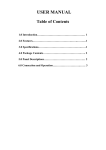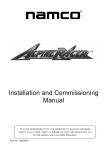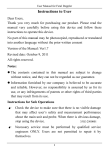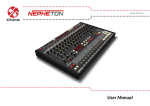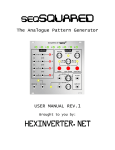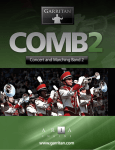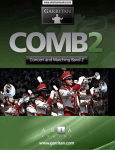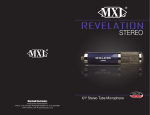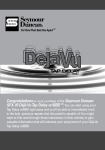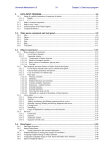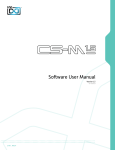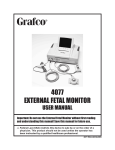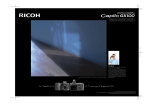Download Preview - PatrickRFBlakley.com
Transcript
The Field Percussion User Manual Patrick R. F. Blakley i The Field Percussion User Manual Written by Patrick R. F. Blakley Cover drum technical drawing by: Clark Fancher Published by Lulu Press Inc. Raleigh, North Carolina, United States. First Printing February 2015 10 9 8 7 6 5 4 3 2 1 Copyright © 2015 by Patrick R. F. Blakley All rights reserved. No part of this book may be reproduced, scanned, or distributed in any printed or electronic form without permission. Please do not participate in or encourage piracy of copyrighted books in violation of the author’s rights. Purchase only authorized editions. LIBRARY OF CONGRESS CATALOGING-IN-PUBLICATION DATA has been applied for. ISBN 978-1-304-06872-9 ii iii iv Congratulations Field on Percussion your unit. state-of-the-art Please read carefully to fully understand each item in this newest model. v vi Tools You Will Need: vii viii Step-by-Step Contents: Suggestions for the use of this book – Page xi Step 1: Understanding Your Percussion Section – Page 15 Step 2: Parts and Pieces – Page 29 Step 3: Numbers and Classifications – Page 45 Step 4: The Front Ensemble – Page 55 Step 5: The Drumline – Page 63 Step 6: Warming up – Page 73 Step 7: Visual Basics – Page 89 Step 8: Percussion Ensemble – Page 99 Step 9: Full Ensemble – Page 107 Step 10: Show Time – Page 115 Troubleshooting guide – Page CXXVII Glossary of Terminology – Page CXXXI ix x Suggestions for the use of this book This book is designed for band directors, visual coordinators, and their related staff to get the most out of working with the group’s percussion sections. The goal is to portray specific details of the inner workings of both drumline and front ensemble so that it can benefit winds and guard more effectively as well as the overall rehearsal objectives of the non-percussion oriented staff. Every section of the group relies on the percussion, especially the battery, for things like tempo maintenance, timing, and drive. It is counterproductive for a percussion section to have to first work through trivial issues, unknowingly set for them by unacquainted staff, in terms of listening situations or miscalculations in either music or drill compositions before undertaking the tasks at hand. Directors should use this book to oversee the group’s interaction with the percussion section. Drill writers should understand the basic needs of their drumline as well as their potential as a visual component. Visual staff should understand the intricacies of the battery’s marching techniques. This book will set the bar for minimum percussive needs and allow for a smooth culmination of the group’s potential with regards xi to percussion oriented accountabilities. Your drumline and pit will have the foundation set to allow them to accomplish their tasks without central problems. Preparing for any fundamental complications pre-season allows for an unobstructed application of goals and objectives for individuals as well as entire groups alike. xii xiii 14 Step 1: Understanding Your Percussion Section 15 16 This is the first step of engaging your marching percussion section: understanding it. This step ranges from central and fundamental concepts down to some minor particulars. This is the most wide-ranging chapter of the book and will prepare you for understanding some of the more intricate chapters as you continue through. Field percussion has one goal, to which the entirety of the group relies upon: tempo. The Drum Major entrusts the drumline to keep exact tempo while the winds and guard use that tempo directly for their own music and choreography to be built atop. The drumline is arguably the most crucial and central section of the entire group. For several reasons the winds should not play every single melody of the show. The pit underlies the ensemble and can easily supplement every musical aspect of the show but it can also advance melodies by extending beyond the winds capacity. The adaptability and variety of the front ensemble mixed with the effectiveness and versatility of the drumline make for a goliath of a musical and visual entity if their realistic potential is appreciated by the staff – of which each ensemble’s potential is different. The best place to begin acquiring the central ideas of the percussion section is tempo. Tempo is not maintained from the Drum 17 Major, it is only derived there. To understand why, we have to understand the physical properties of sound itself. The speed of sound is 1,116.44 feet per second (at sea level in 68oF dry air). This means that if a sound was produced from the back sideline of the football field it would take 0.143 seconds to reach the Drum Major at the front sideline. So, for example, if we allowed the Drum Major to indicate the notes audibly the audible signal has to travel back to the musician and then the musician’s sound has to travel forward to the Drum Major (and then the audience which is even further). That round trip would take over a quarter of a second which works out to a sixteenth-note delay at 105 beats per minute. This is called “Cost of Tempo” which refers to how much tempo it will cost the performer in the back to listen forward. The back hash-mark has a cost of a sixteenth-note at 157 beats per minute and the center ‘X’ has a cost of a sixteenth-note at 210bpm. The same effect is apparent the further to the side the sound comes from. This is less common since most groups remain mostly centered on the field, but it can be more difficult as an audience member at a big show if you’re sitting far out to the side of the stands; this is partly why judges are always centered on the 50 yard line. The problem is compounded when trying to have sections play together from different sides of the field. The distance from the 18 back hash of one thirty yard line to the other is the same as the distance from that back hash on the thirty to the front sideline at center field. This means the Cost of Tempo is compounded when spread out, even only between the thirties. There is a classic test that can be done with 4 snare drums aligned evenly along the 50 yard line from the front to the back sidelines. Let the snare on the front sideline tap-off and everyone plays one note on the downbeat. You’ll hear four distinct notes from the audience’s perspective (the snare player at the back sideline hears all the drums in unison). Then have the back snare drum tap-off for the same thing and the audience will hear all four drums in unison. In the second example the back snare hears the four individual notes and thus demonstrates the first major hurdle for the battery (and more specifically the Center Snare): Anticipation. To counter this sound delay issue we minimize it by establishing the tempo as far back on the field as possible. This in itself completely solves the issue for the audience because each sound joins in unison on its journey to the front of the field and beyond, thus arriving at their destination together. But this presents awkward problems when you are the musician standing at the back of the field, if you listen to the music from there it will all sound wrong because sounds joining up with your initial sound register with your 19 ears separately and very much not together. This problem creates immense pressure when the drumline is trying to play in time. Anticipation will allow a good Center Snare to ignore his ears and trust his judgment for seamless musical entrances. To deal with this issue within the drumline itself the duty of the members is to “listen in”. “Listening in” means that you are responsible for playing exactly with the person next to you (toward the Center Snare in the snareline). If there are nine members of a snareline the farthest outside members have to listen to three interpretations of the Center Snare’s tempo. The Center Snare’s job is to ignore all sound sources other than his own in the exact same way the singer of the National Anthem has to ignore the speakers and echo of their voice in a huge stadium; they continue to sing by listening only to themselves within. The Center Snare plays his show the same way with, or without, the ensemble. The other snares have to play in exact unison while reacting to the Center Snare’s anticipations. This is obviously accomplished through practice, but the drumline does not anticipate the Center Snare’s decisions, that would lead to a very hesitant tempo. Instead, the advantage of any tempo is that it is almost always consistent and unchanging. This means that, while humans will waiver slightly, any choices the Center Snare makes will be small and easy to interpret within the rest of the drumline. 20 Beyond the snareline, the tenorline has to add an extra step to listen in. The center tenor interprets the Center Snare’s anticipation and tempo to give to the tenorline. This allows the tenorline to play ‘clean’ together as a section while the center tenor makes certain the tenor sound lines up with the snare sound. The bassline is fundamentally different because they tend to ‘split’ their music more than they play in unison. The center bass has the same job as the center tenor during unison phrases but any split sections require all of the bass members to use their ears and lock into the Center Snare individually. A key rule for basslines is to never listen to each other on split parts, but instead count and lock into the tempo. If the snareline is tacit while the tenors or basses play alone then each center player takes over the role of the Center Snare in terms of anticipation and tempo. Note: when the tenors and basses play together (without snares) the center tenor has de facto control. Now this issue has separated the two percussion sections, the drumline who is now most beneficial behind the winds, which is the best place for their sound to be produced to control tempo, and the front ensemble which is all the way on the front sideline. The next issue we need to resolve is how to get these two similar sections communicating together without any loss of time. This is easier to do when the drumline is producing sound (the pit can listen to anyone in 21 the battery), but when they have rests there is nothing to drive the tempo forward. Compensating for this is trickier since listening to winds tends to be a little more unclear due to sustained tones. The Drum Major and the front ensemble use the same solution in that they watch the Center Snare’s feet. So even when the Center Snare is tacit he can still dictate tempo to the front of the field. This is less ideal than for the Center Snare to actually play but for many reasons the drumline should not always be playing. Drumlines don’t immediately work together without issues regarding tempo, it takes time for a new set of people to understand their neighbors and the small adjustments they make when adapting to a fluctuating tempo. Metronomes become useful almost immediately, depending on group skill level (the more inexperienced the group the longer it will take to be ready for a metronome). Remember that different percussionists learn differently, meaning that one person may be able to play with a metronome alone but struggle with playing with other people and vice versa. Once the drumline is playing effectively with the metronome it is important to take it away often. Drumlines and individuals that play with the metronome too often become reliant and instead of being able to maintain a tempo on their own they tend to lose tempo faster without their metronome crutch. It is also a good point to make that 22 drumlines don’t always need to play perfectly with the metronome either. It is ideal for them to do so, but if for one reason or another the metronome click becomes an offbeat, and is maintained as such, it is still acceptable; they would have only waivered one half beat over an extended time which isn’t as bad as some people may think (though can be odd when listening or when using cues). It is also a tell-tale sign that the winds are listening back to the battery and not just blindly following the met, if the winds enter with the drums, even if they aren’t with the metronome, you have a well-trained ensemble. More detail is needed for communication of tempo within the drumline however. Again we have to begin with the Center Snare who technically should be the only one listening to the metronome. The reason for this is because we want them to be the only person to actively adapt to the metronome’s tempo. If everyone made adjustments to what they heard it would result in differences of opinion in interpretations of the metronome’s clicks. The outcome of this would be slight tears between random individuals and entire sections of the battery. The Center Snare must be in charge of the metronome and all adjustments to it. To accomplish this feat every member of the drumline has to listen in, carefully and at all times. The front ensemble utilizes the same ideas as the drumline but a bit more on the individual basis. The pit members on 23 melodic instruments can all listen in to the center marimba player, but they also use their eyes to look into the center for verification during rests. The pit does not subdivide audibly as it would be too loud and intrusive; instead they mime mallet strokes to visually lock into the center’s interpretation of the drumline tempo. Other tempo generating and non-melodic pit instruments (such as auxilary) should watch the drumline’s feet directly whenever possible since they are in a difficult position to coordinate with the center marimba. The front ensemble understands the drumline’s tempo and as such the entire percussion section is producing the same tempo. Part of the challenge now is playing the very first note together as one. You cannot listen into a musical note that doesn’t exist so the drumline gets a little creative in finding a solution. The Center Snare simply tells their section the tempo, verbally signifying where they perceive it. This is called ‘subdividing’. We are usually never actually dividing the tempo at all, but instead creating short staccato sounds on the beat with our voice. The aural version of the beat sounds like “dut” with emphasis on the first consonant. Subdividing before a musical entrance begins with the Center Snare, who is audibly telling everyone where he observes the tempo (dictated by the Drum Major). Then everyone will join in with their subdivision in unison as a verifiable check before the first note is 24 played on the instrument. This almost guarantees a clean entrance, but more can be done to ensure a perfect attack. The drumsticks themselves come into play with movements before actually hitting the drum. Tacit sticks are usually held together in the attention position or down at the sides before they are put in the ready position (over the drum head). By moving the sticks to the ready position together we are adding one more checkpoint to warrant a unified first note. Tenors will usually take this one step further by moving their mallets to their target drums on the very last count before they play. All of these audibles and visuals help everyone join together as one before they are meant to play as one. Pit members do similar structured components before playing to make sure they are together as a unit. As a member of the front ensemble your job is to look in (or back) as well as listen back to the subdivision. So the implements again become visual tools for the center marimba to guide others to the beat. This has an added benefit by allowing them to keep their place over the correct bars while using their eyes to connect with the Center Marimba. For more inexperienced mallet players this also helps practice coming down on the correct notes, especially when using four mallets. These ideas are the most fundamental for field percussion units. The derivation of tempo and ability to maintain that tempo 25 through every member of the battery and pit is the key to a successful ensemble. More intricate ideas will be presented in chapters four and five regarding front ensemble and drumline specifics respectively. 26 27 28






























